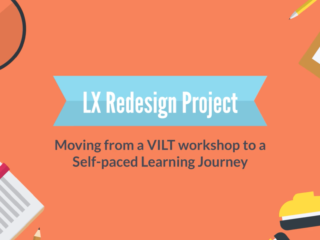The project:
Story based learning experience for leaders on team health.
The challenge:
Develop using Adapt rather than Storyline for greater accessibility but maintain the experience of an interactive story that flows for the learner. This was challenging with the more modular block based Adapt platform. It doesn’t flow easily from one scene to the next like Articulate Storyline.
The elements:
2 videos (before/bad and after/better) 5 health related scenarios, 5 leadership testimonials, 5 sets of best practice tips, and job aids.
The solution:
How did I do it? Simple! I used the two videos to frame the experience, creating a starting and ending point. In between I featured the 5 scenarios inviting the learner to help the manager character to make healthy choices and set them to unfold sequentially using Trickle. Each scenario was formatted as a three-column graphic multiple-choice component. The graphics paired with text descriptions illustrate the scenario and three possible interactions between the manager and her team for the learner to choose from. To simulate the experience of having unique repercussions I set the feedback to display using Tudor and chose custom responses per answer.
“Ron seems annoyed with Gwen and even more disengaged now that his project was reassigned. You tried to relieve his stress by lightening his workload but should have asked what he thought you could do to help first. Gwen loses valuable credibility, respect and trust from Ron.”
After the custom feedback displays, Trickle then reveals the best answer, practice tips and a peer testimonial for how to support the healthy behavior demonstrated in the scenario. Then it flows to the next scenario. Once all the scenarios are viewed the learner is presented with the after video showing the manager and her team in a much better place.
The conclusion:
By stringing together mini-scenarios in between a start and end in the story you can simulate a story based learning experience in a block based platform. While it wasn’t truly immersive the learner is involved in the story, encouraged to explore, and gets a sense of accomplishment at the end.
I hope this inspires you to try out Adapt for story based learning using mini-scenarios!




Leave a Reply